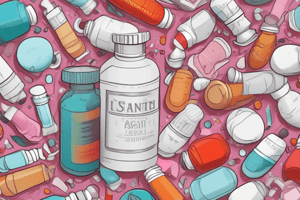Podcast
Questions and Answers
What was one of the leading causes of accidental death in children before the introduction of child-resistant containers?
What was one of the leading causes of accidental death in children before the introduction of child-resistant containers?
- Fatal heart attacks
- Chronic intoxication
- Respiratory alkalosis
- Salicylate overdose (correct)
What is the primary mechanism of toxicity of salicylates?
What is the primary mechanism of toxicity of salicylates?
- Hyperventilation leading to respiratory alkalosis (correct)
- Analgesic effects
- Anti-inflammatory effects
- Inhibition of platelet aggregation
What is the blood concentration of salicylates in arthritis patients?
What is the blood concentration of salicylates in arthritis patients?
- 600 mg/L
- 100-300 mg/L (correct)
- 10-30 mg/dL
- 60 mg/dL
What is a indication of aspirin?
What is a indication of aspirin?
What year was aspirin distributed to doctors and became the number one drug worldwide?
What year was aspirin distributed to doctors and became the number one drug worldwide?
What is the consequence of chronic intoxication of salicylates?
What is the consequence of chronic intoxication of salicylates?
What is the level of salicylates considered very dangerous?
What is the level of salicylates considered very dangerous?
What is the effect of hyperventilation caused by salicylate toxicity?
What is the effect of hyperventilation caused by salicylate toxicity?
What is the consequence of salicylate overdose?
What is the consequence of salicylate overdose?
In a patient with salicylate overdose, which of the following factors contributes to worsening toxicity?
In a patient with salicylate overdose, which of the following factors contributes to worsening toxicity?
Which of the following interventions is considered the most effective in rapidly reducing serum salicylate levels in a patient with salicylate overdose?
Which of the following interventions is considered the most effective in rapidly reducing serum salicylate levels in a patient with salicylate overdose?
A patient presents with a history of acute salicylate ingestion. The clinician decides to utilize a nomogram to estimate toxicity. What is the primary reason for this decision?
A patient presents with a history of acute salicylate ingestion. The clinician decides to utilize a nomogram to estimate toxicity. What is the primary reason for this decision?
What characteristic arterial blood gas findings are typically observed in a patient with salicylate overdose?
What characteristic arterial blood gas findings are typically observed in a patient with salicylate overdose?
Which of the following is NOT a common symptom associated with overdose of most NSAIDs?
Which of the following is NOT a common symptom associated with overdose of most NSAIDs?
Which of the following NSAIDs is NOT mentioned as causing seizures and coma in overdose?
Which of the following NSAIDs is NOT mentioned as causing seizures and coma in overdose?
Which of the following is a potential complication of repeat-dose activated charcoal therapy in a patient with salicylate overdose?
Which of the following is a potential complication of repeat-dose activated charcoal therapy in a patient with salicylate overdose?
Which of the following statements accurately describes hemoperfusion in the context of salicylate overdose?
Which of the following statements accurately describes hemoperfusion in the context of salicylate overdose?
Why is it important to obtain serial serum salicylate concentrations in a patient with salicylate overdose?
Why is it important to obtain serial serum salicylate concentrations in a patient with salicylate overdose?
Which of the following NSAIDs is an alternative to morphine for nonsurgical procedures?
Which of the following NSAIDs is an alternative to morphine for nonsurgical procedures?
What is a potential use of vitamin K in relation to NSAID toxicity?
What is a potential use of vitamin K in relation to NSAID toxicity?
What mechanism of action is primarily linked to the toxicity effects of NSAIDs?
What mechanism of action is primarily linked to the toxicity effects of NSAIDs?
In which situation would activated charcoal be administered?
In which situation would activated charcoal be administered?
Which of the following is NOT mentioned as a specific antacid used for gastrointestinal upset?
Which of the following is NOT mentioned as a specific antacid used for gastrointestinal upset?
What is a common toxicity effect of NSAIDs on the body?
What is a common toxicity effect of NSAIDs on the body?
Which NSAID is classified under the fenamates?
Which NSAID is classified under the fenamates?
What is the role of intravenous crystalloid solutions in the management of NSAID toxicity?
What is the role of intravenous crystalloid solutions in the management of NSAID toxicity?
Which of the following statements about NSAID antidotes is true?
Which of the following statements about NSAID antidotes is true?
What is a significant effect of increased acid buildup in the body?
What is a significant effect of increased acid buildup in the body?
Which laboratory test is critical for evaluating metabolic acidosis?
Which laboratory test is critical for evaluating metabolic acidosis?
What treatment should be avoided if the serum pH falls below 7.4?
What treatment should be avoided if the serum pH falls below 7.4?
What condition is related to the alteration in capillary integrity during metabolic acidosis?
What condition is related to the alteration in capillary integrity during metabolic acidosis?
Which of the following is NOT part of the emergency measures for treating metabolic acidosis?
Which of the following is NOT part of the emergency measures for treating metabolic acidosis?
What acute intervention is necessary for patients exhibiting signs of pulmonary edema?
What acute intervention is necessary for patients exhibiting signs of pulmonary edema?
What is the average therapeutic single dose of aspirin for adults?
What is the average therapeutic single dose of aspirin for adults?
What symptom is associated with altered platelet function during metabolic acidosis?
What symptom is associated with altered platelet function during metabolic acidosis?
What condition can be caused by prolonged acidosis and hypoventilation?
What condition can be caused by prolonged acidosis and hypoventilation?
What is the primary treatment recommended for NSAID overdose in a hospital setting?
What is the primary treatment recommended for NSAID overdose in a hospital setting?
Which of the following symptoms is NOT commonly associated with NSAID overdose?
Which of the following symptoms is NOT commonly associated with NSAID overdose?
What is a significant limitation of hemodialysis in the treatment of NSAID overdose?
What is a significant limitation of hemodialysis in the treatment of NSAID overdose?
What range of ingestion is considered a toxic dose of NSAIDs?
What range of ingestion is considered a toxic dose of NSAIDs?
What effect does chronic intoxication of NSAIDs have on the gastric mucosa?
What effect does chronic intoxication of NSAIDs have on the gastric mucosa?
Which one of the following is a potential side effect of NSAID overdose?
Which one of the following is a potential side effect of NSAID overdose?
Charcoal hemoperfusion is indicated specifically in the overdose of which NSAID?
Charcoal hemoperfusion is indicated specifically in the overdose of which NSAID?
Which of the following is generally the result of NSAID overdose?
Which of the following is generally the result of NSAID overdose?
In the context of NSAID overdose treatment, what is the role of activated charcoal?
In the context of NSAID overdose treatment, what is the role of activated charcoal?
Flashcards are hidden until you start studying
Study Notes
Aspirin and Salicylates
- Aspirin (acetylsalicylic acid) was developed in 1897 and became the most widely used drug by 1915.
- Four main indications for aspirin: anti-inflammatory, analgesic, antipyretic, and antiplatelet (inhibits platelet aggregation).
- Salicylate overdose was a leading cause of accidental death in children before child-resistant containers were introduced.
Mechanism of Toxicity
- Salicylates can cause multiple toxic effects:
- Hyperventilation leads to respiratory alkalosis (increased blood pH) due to carbon dioxide loss.
- Metabolic acidosis occurs with higher blood salicylate levels (>600 mg/L) and can alter mental status.
- Chronic therapeutic concentrations in arthritis patients range from 100 to 300 mg/L.
- Uncoupling of oxidative phosphorylation disrupts glucose and fatty acid metabolism.
- Cerebral and pulmonary edema can develop due to capillary integrity alterations.
Treatment Protocols
- Emergency measures include maintaining airway and ventilation, administering supplemental oxygen, and monitoring arterial blood gases and chest x-rays for pulmonary edema.
- Treat coma, seizures, pulmonary edema, and hyperthermia; administer intravenous sodium bicarbonate for metabolic acidosis.
- Replace fluids and electrolytes lost to vomiting and hyperventilation with intravenous crystalloid solutions.
- For acute ingestion, salicylate levels are plotted on a nomogram to estimate toxicity and treatment efficacy.
- Repeat-dose activated charcoal therapy can reduce serum salicylate half-life.
NSAIDs Overview
- Nonsteroidal anti-inflammatory drugs (NSAIDs) include various agents for pain and inflammation control.
- Common examples: ibuprofen, naproxen, ketorolac, mefenamic acid, and piroxicam.
- Typical overdose effects are mild gastrointestinal upset, but serious outcomes like seizures and coma can occur.
Mechanism of NSAID Toxicity
- Toxicity commonly results from cyclooxygenase inhibition, affecting the CNS, hemodynamic, pulmonary, and hepatic systems.
- Acute or chronic NSAID use can harm gastric mucosa and renal blood flow due to decreased prostaglandin synthesis.
Clinical Signs of NSAID Overdose
- Generally asymptomatic or present with mild gastrointestinal symptoms (nausea, vomiting, abdominal pain).
- Severe cases may exhibit drowsiness, lethargy, ataxia, tinnitus, and disorientation.
Treatment of NSAID Overdose
- There is no specific antidote for NSAID overdoses; treatment focuses on symptom management.
- Activated charcoal administration may be effective in both prehospital and hospital settings.
- Enhanced elimination methods like hemodialysis are generally ineffective due to high protein binding and large volume distribution of NSAIDs.
Studying That Suits You
Use AI to generate personalized quizzes and flashcards to suit your learning preferences.




